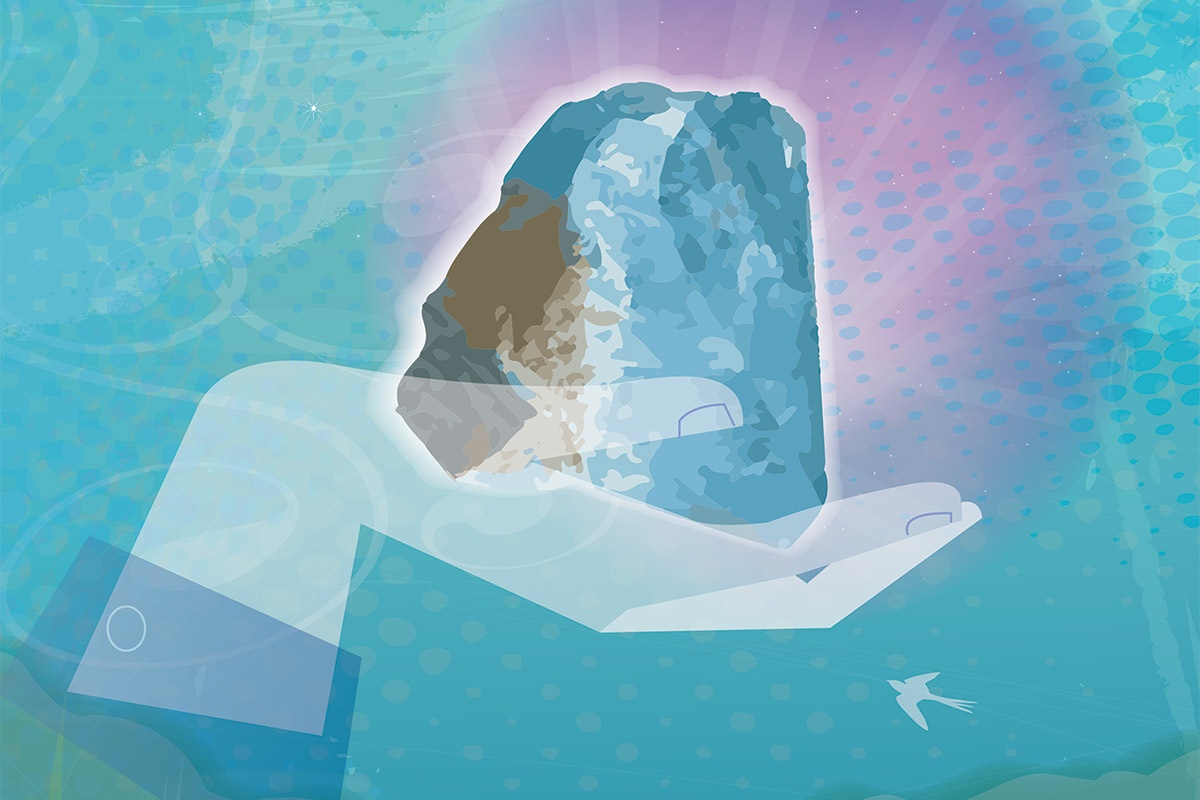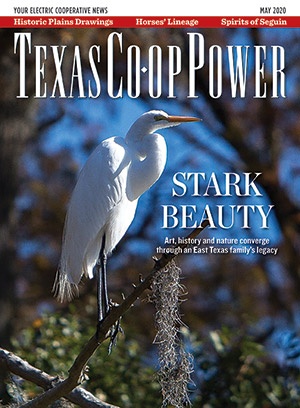Frank Roberts has helped people from as far away as Belgium and France look for Texas’ official state gem.
“There’s something about finding a sparkly rock that’s been in the ground for a billion years,” says Roberts, a member of Pedernales Electric Cooperative, who guides guests to Central Texas on quests for Texas topaz. “Once they find it, they’re hooked.”
Texas blue topaz certainly stands out as a rare and prized stone. Mason County is the only county in Texas where the official state gem can be found, making it a frequent destination for visitors eager to pluck their very own from the ground.
The go-to guy in Mason for all things topaz is Warren Grote, proprietor of Mason Country Collectibles downtown and a member of Central Texas Electric Cooperative. He tells a story about one couple who walked into his store a few years back. They were on their first vacation in 21 years. They had stayed close to home because their son was born with Down syndrome and required extensive care. Grote explained how best to search for topaz and sent them on their way with all the tools they needed for a chance to find themselves a Texas gem.
Three ranches in Mason County offer public topaz hunting—Bar M Ranch, Lindsay Ranch and Seaquist Ranch. All require advance reservations. The Lindsay and Seaquist ranches are open mid-January through fall, and Bar M Ranch is open from February through September. Topaz hunting on the Lindsay Ranch is available only to overnight guests at its ranch houses and campsites.
If you strike out after such a quest, there are several places in Mason that sell Texas blue topaz, which became the official state gem March 26, 1969, when Gov. Preston Smith signed House Concurrent Resolution No. 12 into law.
Topaz requires a lot of aluminum and growth from hot, fluorine-rich fluid near the end stages of granite crystallization, says Mark Helper, a senior lecturer in the University of Texas’ geosciences school. The granite plutons in the Llano Uplift in Mason County are the only masses known to bear topaz in Texas.
Topaz naturally occurs in many colors, including yellow, pink and brown. Pure topaz is colorless; chemical impurities give it its color. A natural blue topaz—one of the rarer colors—is caused by imperfections in the arrangement of its atoms. Some of the brighter blue topaz is obtained by irradiating colorless topaz, making it an accessible and popular variety. Most of the topaz found in Mason County is colorless or light blue. Topaz is found in other states and on every continent. Brazil is the largest producer.
The best time to hunt for topaz is after a good rain, when the ground is soft and the creek beds are stirred up. Look for it around granite outcroppings and near creeks. Your ranch hosts will direct you to the best spots on their property. You’ll need a small shovel and a fine screen for sifting. Gloves, sunscreen, closed-toe shoes and a hat are recommended. These are working ranches, so be mindful to leave the land how you find it, including filling in any holes that you dig. Do not enter private property without the owner’s permission.
To learn more about topaz, head to the Mason Square Museum, where you’ll see the largest known light blue topaz discovered in North America, found in Mason County in 1904 by Albert McGehee. It’s said that McGehee used the 6,480-carat crystal as a doorstop before the Smithsonian Institution bought it from him for $75 in 1913. It’s now at the museum on loan from the Smithsonian, along with several other pieces of topaz.
When you’re ready to buy, Country Collectibles sells raw and cut gems in a variety of sizes and shades. Many are faceted in the Lone Star cut, the official state gemstone cut. Check out Grote’s 587.15-carat light blue topaz, named the Grand Azure.
Grote finishes his story about the couple that stepped into his store many moons ago. They sent him a postcard when they returned home. On their quest, they discovered a large piece of topaz as well as a translucent arrowhead thought to be made out of quartz circa 9000 B.C.
“That’s my all-time favorite story,” Grote says. He told them, “God’s rewarding you for your faithfulness to your son.”
Brenda Kissko writes about nature, travel and our relationship with land. Read more of her work at brendakissko.com.


